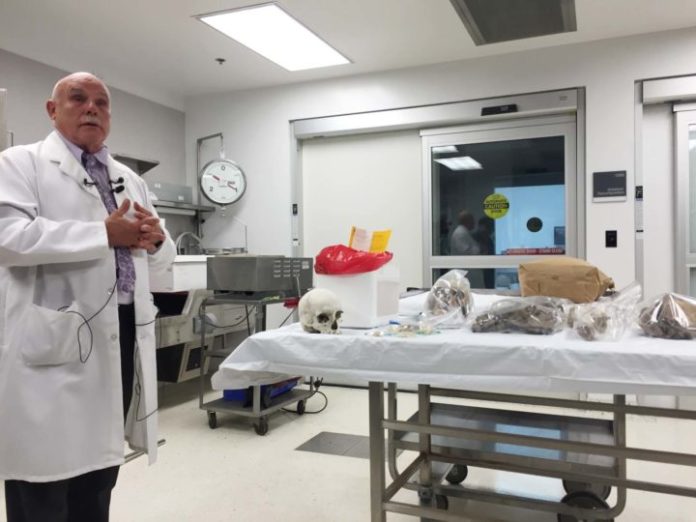By Gig Conaughton, County of San Diego Communications Office
Sep. 23, 2019
Drugs, alcohol, vehicles, falls, guns and suicide continue to be leading causes of deaths investigated by the San Diego County Medical Examiner’s Office, according to its just-released 2018 Annual Report.
Suicides increased from 458 in 2017 to 465, continuing a trend that has seen suicide numbers increase 13% over the past 10 years, taking population growth into account. Homicides decreased from 106 to 104. And accidental deaths, which include fatalities from drugs, alcohol, falls, traffic, drowning, choking, asphyxiation and other causes, increased from 1,522 in 2017 to 1,583.
“Every case represents a person’s death, mourned by loved ones and friends,” said County Medical Examiner Dr. Glenn Wagner, explaining that the numbers are more than statistics.
“We publish these numbers in this report and through the County’s Open Data Portal,” Wagner said, “to give us all opportunities to learn about injuries and illnesses, find ways to address risks and hopefully, save lives in the future.”
Both the annual report, which covers the 2018 calendar year, and quarterly reports including one for the first three months of 2019, can be found on the Medical Examiner’s Reports and Statistics webpage.
Some of the 2018 Annual Report’s findings included:
•The three leading causes of accidental and sudden, unexpected deaths —accounting for 88% of all accidental deaths — were drugs, falls, and being killed in or by vehicles.
•577 deaths were caused by overdoses: from illegal drugs, from misused or illegally obtained prescription drugs, and alcohol. Of those, fentanyl deaths continued to rise, from 33 in 2016, to 84 in 2017 and 92 in 2018. Methamphetamine deaths also increased by 21% in 2018.
•488 people were killed by falls, mainly in the home, but also at jobs, outside in rural and urban areas, from bridges, mountains and beach cliffs.
•316 people — 24 more than 2017 — were killed by being hit by vehicles, or in vehicle accidents. That included 107 pedestrians, an increase of six over 2017, which was already the highest number of pedestrian deaths in San Diego County in 24 years.
•Motorcycle wrecks killed 48 people, a 51% decrease.
•Accidental drownings in bathtubs and spas increased significantly, from eight to 18 in bathtubs and from three to 10 in spas.
•Firearms killed 235 people: 61 in homicides and 174 in suicides.
•Men made up 68% of all the deaths the Medical Examiner’s Office fully investigated: 2,196 men to 1,034 women.
Under law, the County Medical Examiner’s Office investigates all “unnatural” deaths, such as suspected homicides, suicides, accidents, and natural deaths that are sudden and unexpected.
In 2018, more than 22,000 deaths occurred in the county. The Medical Examiner’s Office was asked to investigate 8,346. Of those, initial investigations determined that 5,115 deaths were natural and needed no further investigation by the Medical Examiner, leaving 3,232 for full investigations.
Of that group, another 1,031 were concluded to be from natural causes, 1,583 were deemed accidental, 51 could not be determined, 102 were homicides and 465 were suicides.
Last week, the San Diego County Suicide Prevention Council released its own annual report that said suicides remain a significant issue, but one that people can help prevent because the great majority of suicide victims show warning signs.
Wagner said this week that the County urges anyone who is struggling with depression or is concerned about a loved one to seek free mental health and substance abuse counseling. People can call the County’s Behavioral Health and Crisis Line at (888) 724-7240. Suicide prevention and awareness information is also available at the It’s Up to Us website.
Wagner said the Medical Examiner’s annual reports are used by law enforcement, mental health and drug rehabilitation communities and mental health communities. He said the County also uses them to guide its initiatives, including Live Well San Diego and associated task forces on suicides, elder abuse, domestic violence, child deaths and methamphetamine and prescription drug abuse.
“The dead present us with an opportunity to learn from their story,” Wagner said, “a story worth telling.”
To see this year’s report and past years’ reports, go to Medical Examiner’s Reports and Statistics webpage. Medical Examiner’s individual case records can be seen on the County’s Open Data Portal. The portal gives the public access to more than 61,000 cases, through March 2019.
For more information about the County Medical Examiner’s Office, go to its website.
Here are graphics comparing statistics from the Medical Examiner’s 2017 and 2018 reports, and the first quarters of 2019 and 2018, from January to March 2019, with January 2018 to March 2018:




















